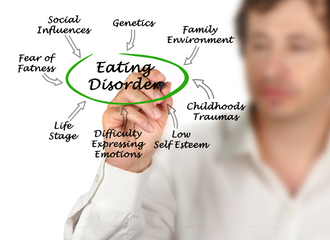Written by: Samantha DeCaro, PsyD
Director of Clinical Outreach and Education, The Renfrew Center
Residential eating disorder treatment offers a more intensive way to address eating disorder symptoms – especially those that are too hard to manage individually or at home. In this post, we review the top 3 ways residential care can help.

Eating disorder symptoms, such as restricting, bingeing, purging, and/or over-exercising will sometimes become so unmanageable and overwhelming that many find it nearly impossible to break the cycle at home even with the guidance of an outpatient team.
In these cases, a more intensive option such as residential treatment might be necessary to combat the eating disorder symptoms.
What is Residential Eating Disorder Treatment?
An eating disorder can be treated at any age and at any stage, however it is ideal to catch it and treat it as early as possible.
There are various levels of care for an eating disorder, and the recommendation one receives depends on the severity of the eating disorder symptoms.
Levels of care include:
- Outpatient treatment (OP)
- Intensive outpatient programs (IOP)
- Partial hospitalization programs (PHP)
- Residential treatment (RES)
- Inpatient hospitalization (IP)
Residential treatment is one of the highest levels of care available for an eating disorder and is considered one step below inpatient hospitalization. In residential care, patients live at the facility, receive ongoing medical monitoring, and participate in various forms of therapy.
How Long Does Residential Treatment Last?
The length of stay in a residential setting can vary depending on the medical and emotional goals developed by the patient and their team. Treatment can last for a few weeks to a few months, or more.
Eating disorders thrive in isolation and are further fueled by shame, secrecy, malnourishment, fear, and irrational beliefs. Residential treatment specifically targets these issues and creates an environment where an eating disorder cannot easily survive.
Top 3 Ways Residential Treatment Helps
Here are three of the biggest ways residential treatment helps successfully interrupt the eating disorder cycle.
1. Structure That Stabilizes
Creating structure, within each day and each week, helps to stabilize even the most severe eating disorders.
Eating disorders impact all systems of the body, including the body’s built-in signals. Eating a variety of meals and snacks on a predictable schedule helps us tune into pleasure, hunger cues and fullness cues. Many folks with eating disorders have difficulty noticing their body’s inner world; the structure of mealtime aids in reestablishing the important connection between brain and body.
In the early stages of residential care, residents communicate their general food preferences to their nutritionists. To eliminate and reduce the stress associated with shopping, preparing, cooking, and portioning out food on their own, all meals are pre-assembled and served to the residents at mealtime. As residents learn skills and gain confidence, they become ready for new challenges, including choosing food in the moment and managing urges with less supervision during and after meals.
Between mealtimes, residents participate in individual therapy, family therapy, various types of group therapy, and weekly individual sessions with the members of their treatment team. In addition, free time is built into the weekly schedule. Free time allows residents to practice coping with the feelings that arise during unstructured times of rest or socialization.
2. Supervision to Break the Cycle
Recovery can be quite challenging both physically and emotionally. Intense urges, uncomfortable sensations, and frequent, intrusive eating disorder thoughts can make it difficult to break the symptom cycle without some level of supervision and accountability. In residential care, patients have a treatment team of experienced therapists, nutritionists, psychiatrists, nurses, and milieu counselors who are there to support them during their stay.
In this controlled environment, the team encourages residents to experiment with new behaviors, including speaking honestly about urges and behaviors, expressing emotions authentically, identifying needs, and asking for extra support when needed. (Renfrew’s treatment model is designed to help you learn how to effectively deal with uncomfortable emotions, so you no longer need to use eating disorder symptoms. When a resident feels ready, they will design new emotional challenges with the help of their team, such as eating out at a local restaurant or trying on new clothes at the mall.)
3. A Supportive Environment
Eating disorders are disorders of disconnection, and healing happens within the context of a supportive and compassionate community.
In residential treatment, you live amongst other residents who truly understand what it is like to have an eating disorder and what it takes to recover from it. Certain support groups are divided by age, by identity, and by diagnosis so that even smaller communities form within the larger one.
Residents often bond with each other during free time by hanging out in the healing garden, watching movies in the living room, creating art projects, praising each other for acts of courage, and encouraging each other when times get tough. Some of these residents might become your support system for years to come. (Many Renfrew residents stay in touch by attending reunions, attending lower levels of care, or joining virtual alumni workshops and support groups together.)
How Do You Know If You Need Residential Treatment?
Eating disorders thoughts frequently convince folks that they are not sick enough for treatment, so it can be exceedingly difficult to recognize when a higher level of support is needed. The American Psychiatric Association (APA) developed specific guidelines for medical and mental health providers to use when recommending the appropriate level of care.
A qualified eating disorder specialist can provide a thorough assessment to identify which level of care would best fit your needs. Recovery can be difficult, but it is much less difficult when you have the structure, supervision, and the support you deserve.
Here are some signs that you might meet criteria for residential treatment:
- You are experiencing physical or emotional issues due to your eating disorder.
- No matter how hard you try, you are not able to stop restricting, bingeing, over-exercising, and/or purging on your own.
- You are simultaneously dealing with an eating disorder and other issues, such as trauma, substance abuse, and/or another mental health diagnosis such as depression, OCD, or anxiety.
- You experience intrusive eating disorder thoughts multiple times throughout the day.
- You feel it would be helpful to have access to a larger network of supportive professionals and peers.
Conclusion
Even when someone clearly meets criteria for residential treatment, various factors can sometimes get in the way. Common barriers include the thought that other people or other obligations – such as work or school – should be prioritized over treatment. Some people want to wait for a better time – or the perfect time – to suddenly appear. Other systemic barriers interfere with accessing care as well, especially for marginalized populations.
If you are struggling with prioritizing your health and accepting the need for treatment , I hope a gentler, inner wisdom breaks through the noise, reminding you that we cannot effectively care for others without caring for ourselves first. That voice of wisdom knows that the perfect time for treatment does not exist in the future. It knows that we all deserve to break free from the patterns that no longer serve us. It knows that the ideal time for recovery and for healing is always now.






